Chicken meat, chicken eggs are healthy products that everyone has on the table. Therefore, the breeding of chickens is not only a profitable business, but also a payback. However, before deciding to start breeding chickens, it is still worth exploring in detail all the nuances of chick breeding, housing and rearing.
In this article, we will talk about growing chickens at home for beginners, learn how to raise chickens, why chickens diarrhea, what to give broilers from diarrhea and about other pressing issues.
Table of contents
How to choose chickens when buying?
Growing chickens from an incubator at home is a profitable business, because in addition to meat and eggs, you can successfully use the feathers of birds, manure as organic fertilizer. But in orderfor this business to be beneficial, it is necessary to choose the right chickens.
The right time to buy chicks is April-May.. It is advisable to acquire daily chicks. It is better to acquire chicks in poultry farms, because in these places there are guarantees that the individuals are healthy and strong. However, in order to select chicks, it is necessary to know the nuances of selection, depending on the age of the individuals.
Per diem
In order not to make a mistake and acquire healthy day-old chicks at the time of purchase, you must pay attention to a number of criteria for the appearance of young individuals:
- Chick must be driedhealthy and active;
- Pooh should not be stuck together. In appearance he must be fluffywithout dirt and debris;
- At daily young stock at the time of sale umbilical cord should overgrow;
- Be sure to carefully examine the umbilical cord. If there are secretions on it, then this young stock is not worth buying. Discharge is the first sign of an infectious disease;
- Cloaca must be clean, pink color with a wet structure. It should not be dirt, traces of the litter;
- Chicks should be reaction to sounds;
- The back should be straight;
- The head must be level;
- Smooth and regular beak with pigmented structure.
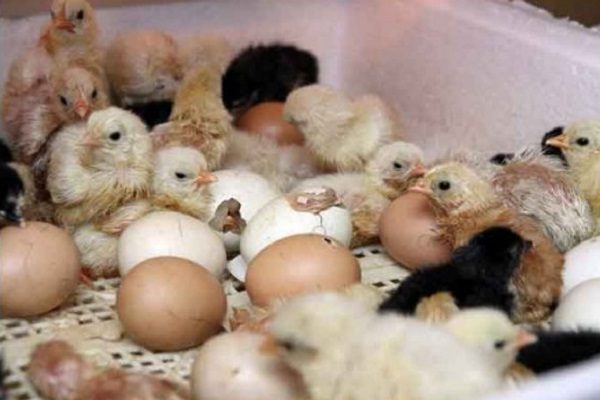
Weekly
Sometimes poultry farmers buy week-old chicks to save money and time. However, this is not always the right and right decision. Juveniles at this age are prone to disease. In addition, their bodies are weak and not strong.
But if you still decide to purchase weekly chicks, the following selection criteria should be considered:
- Individuals must be active and healthy;
- The plumage must be fluffy, no dirt, no traces of litter;
- The belly should be soft to the touch;
- The head is even, proportional;
- Beak straight with pigmented structure;
- Good response to sounds;
- Must already be worked out pecking reflex;
- Wings should be tightly pressed to the body;
- The cesspool should be clean, pink without dirt and discharge.
Monthly
Chicks of one month of age are rarely purchased for divorce. But still some farmers believe that during this period, individuals survive better and have developed immunity against infectious diseases. Perhaps this is true, but do not trust this criterion.Sometimes the monthly individuals get sick much more often.
In any case, the criteria for selecting monthly chicks are the same:
- Activity and mobility;
- Good response to sounds;
- Plumage - fluffy, without dirt, droppings, with a smooth structure;
- The belly should have a soft texture;
- The head must be level and proportionate;
- The beak should have an even outline with a pigmented structure;
- Chicks should already be well developed. pecking reflex;
- It is worth paying attention to the wings, they should be tightly pressed to the body;
- The cesspool should be clean, pink, free from stains from litter and discharge.
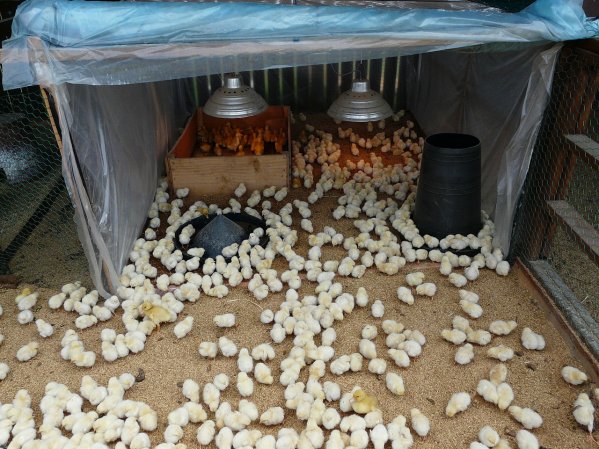
Which is better: grow with a hen or in an incubator?
Features hatch with a hen for beginners
How to grow a chicken from an egg at home without an incubator? Some experienced farmers prefer brooding under the hen because it is a natural process.
But do not immediately lay under her eggs, it is advisable to observe the behavior of an individual for some time. You need to let the chicken sit around The ready-made hen to incubate, when pulling it out of the nest, makes a bubbling sound and rushes back with all its forces to incubate into the nest. In this case, the cultivation of day-old chicks at home will be quite economical.
Depending on the mass of the individual under it lay from 11 to 21 eggs. Place for incubation must be separated from the rest of the chickens. For the incubation site, you can use a separate cage or install a nest in a dark corner of the hen house.
Be sure to feed the henso that she does not die of hunger and exhaustion, which often happens. It is necessary to force the chicken to be removed from the nest and feed, water 2 times a day.
Chickens with a hen hatch in 20-21 days. Sometimes there are cases when a hen, without waiting for a complete hatch, can throw the remaining eggs and go for a walk with the already hatched individuals. Therefore, to prevent these unpleasant problems, those individuals that have already been bred, are deposited in a box or in a warm place, a lamp is installed above them. At 22-23 days the family is combined.
Pros:
- Natural process;
- High survival rate;
- Chicks from the time of breeding and in the subsequent period are together with the hen;
- Economical. This method will require fairly low financial costs.
Minuses:
- Long process;
- Low number of hatchlings per season;
- There is a possibility during the incubation of the chickens hen eggs;
- Withdrawal of chickens in this way can be obtained only once per season and only in warm weather.

Features of growing chickens in the incubator at home and their feeding
Breeding chickens using an incubator is in great demand, and for this the advantages of growing chickens after an incubator speak, among which it is worth highlighting the main ones:
- Favorable application. In one season, the incubator is used up to 10 times;
- Simple use. It is easy to handle with this device, it does not need to be fed, watered, and there is no need to worry that the hen will cut the eggs;
- At a time, you can lay 50 eggs and above;
- All year round chicks. In these devices, all functions are provided that provide output in winter and summer.
Depending on the functions, the incubators are mechanical, manual and automatic.
In a manual incubator, each egg is turned over manually.. The use of a mechanical incubator is almost the same as that of a hand-held device. However, in this type of incubator, turning not one egg, but all of them at once. In addition, compliance with the control of humidity and temperature in both types of devices lies entirely on the owner.
But devices with automatic turning of eggs greatly simplifies the life of the farmer, because they have a digital thermostat installed. During the laying of eggs, it is necessary to establish a certain temperature, and it remains stable during the subsequent incubation period.
If the temperature rises sharply or drops, the mechanism makes a sharp sound.. In addition, eggs are turned every hour, which prevents the embryo from sticking to the shell, and increases the survival rate of the chickens. However, these devices are expensive. But the only way you can grow healthy chickens.
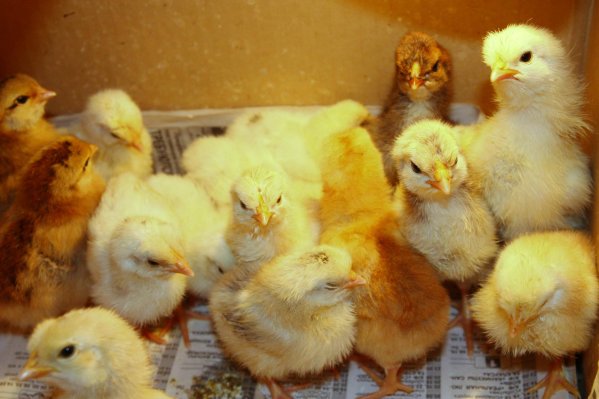
Conditions of detention
The room
Keeping chickens after an incubator at home is easy. Remember a few rules for the care of the room for chickens:
- An important condition of the room is cleanliness. Be sure to clean every day at the place where chicks are housed, scavenge garbage, half-eaten food. Otherwise, infections may quickly appear in an uncleaned area;
- If there is a litter in the house, then it is regularly changed. It should always be clean and dry;
- It is not desirable that a large number of bird stock be present at the place of detention. It is important to provide young animals with free space so that they can freely walk, run, fully exercise all motor functions;
- Number of livestock directly depends on the area of the place for keeping chicks.
Shine
The second important condition for keeping chicks is light.Duration of daylight depends on the age of the young.
Since the first days of the chicken’s life, it is necessary to maintain the duration of daylight at least 18 hours. This value is then reduced to 10 hours before the chicks reach 4 months of age.
These figures do not depend on the type of breed of chickens. In addition, it is absolutely unimportant why the bird is grown - for eggs or meat, this indicator should remain unchanged. The length of daylight in the winter time can be maintained by the presence in the room where the individuals are kept, additional lighting.
You may also be interested in the following chickens articles:
- How to use the "Hen" incubator?
- How to treat infectious and not only chicken diseases?
- How to feed laying hens at home?
Temperature for breeding healthy individuals
Temperature parameters depend on the age of the bird:
- For diurnal individuals up to 5 days of age, a suitable temperature in the room is considered to be +32 degrees Celsius;
- With the onset of 6 days of life and up to 9 days, the temperature gradually drops to +28 degrees Celsius;
- From day 10 to day 20, the temperature regime decreases by another 3 degrees +25 degrees Celsius;
- In the subsequent period, the temperature should be maintained from +20 degrees to 24 degrees Celsius.
Nutrition
What to give in the first days of life
Feeding the chicks should be started immediately after hatching.. But still, it is worth waiting for some time to dry, to get a little stronger.
In the feeder with a flat base or just at the bottom of the box should be poured a small amount of corn grits. This croup has a small structure, so this feed will be most suitable for newborn chicks.
Feeding day-old chicks
Nutrition of diurnal individuals, in contrast to newly hatched chicks, is already more diverse. In addition to corn grits, individuals can be given other types of feed:
- Semolina;
- Barley grits;
- Millet;
- Oatmeal in a ground form;
- Wheat groats.
The feeding process of day-old chicks should be carried out every two hours.. Feed should be given in small portions. It is advisable not to mix cereals, otherwise some individuals will start to choose the most liked food and will eat only it. Therefore, it is best to give the feed mixture separately and in dry form.
For full growth and development, in addition to croup, chicks should be given other components. Cottage cheese is very useful for young individuals. Thanks to this product, the chick's body is saturated with nitrogenous substances and calcium. Cottage cheese can begin to give from 2-3 days after the appearance of chicks in the morning, pre-mixed with cereals.
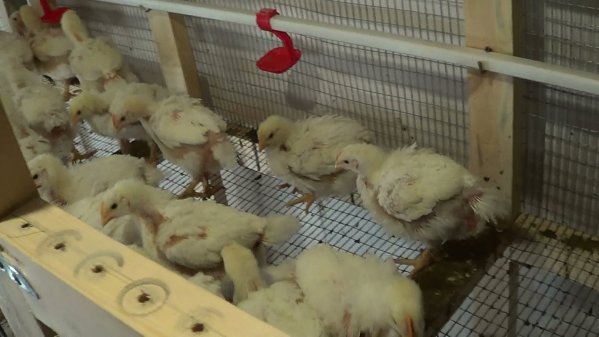
It is worth remembering that dairy products provide high value for babies. Instead of water, you can pour whey or liquid kefir into the drinker. On the third day, individuals can be fed greens.For feed, you can use plantain, clover, dandelion, nettle, snapper. On the 5th day should enter the green onions. Chives have a beneficial effect - it provides high protection for the body against various intestinal diseases.
Weekly
Individuals of a week old can already begin to give a mixture of corn, barley, oat and wheat cereals. Cereals are mixed in equal proportions - 1: 1.
Additionally, you can add chopped greens and dairy products to the mix. During this period, individuals can already be fed less often, but the portions should be large. Up to 4-5 feeds should be received per day.
Monthly
From a month and more, chicks are released outside for walking. For this reason, the diet during this period is green. During the use of herbs and other greens, individuals receive the vitamins necessary for their growing organism.
Besides coarse grains are introduced into the ration. From one and a half months, adults should be fed whole grains. You can give meat and bone meal and food waste.
How to determine the sex of a chicken: chicken or rooster?
In the egg
How to determine the chicken from the cock in the egg? Not many poultry farmers will be satisfied when, after hatching, the percentage of roosters will be almost 80-90%. Therefore, in these cases, the method of determining the sex of a rooster or hen by egg is used. It would seem that this task is difficult and almost impossible, but this is far from the case.
Recommendations will help to determine the sex by egg:
- First you need take the egg in your right hand, while the sharp end of the egg should be directed upwards;
- Further hold the finger of his left hand on its top;
- If there is a ring and tubercles at the upper end, then these criteria indicate that a cock appears. If the top of the egg has a smooth structure - chicken.
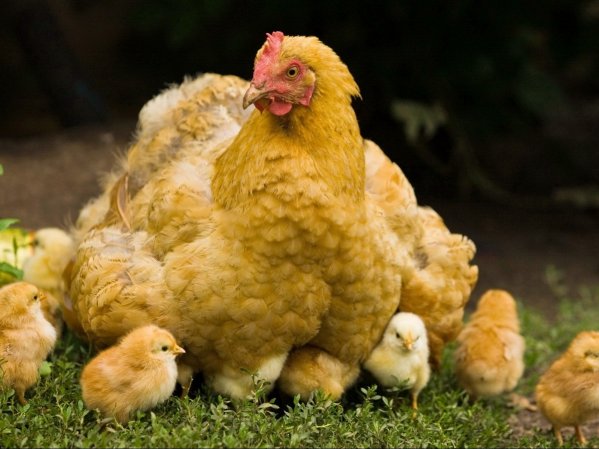
At day old
How to distinguish a chicken from a cock at the age of one? At the age of one day, sexual signs do not appear clearly; therefore, it is quite difficult to determine gender. Females usually have more plumage, but on the contrary, the males are scanty, in some places they can be without fluff.
In 2 months
How to distinguish a rooster from a chicken in 2 months? At this age, gender can be determined using several methods:
- By plumage. Individuals with abundant plumage turn out to be females, while those with poor feathering turn out to be males;
- By this age, the cockerel has a scallop, the beard turns red, and the face is rounded;
- In males, the legs are longer, you can already see the spurs on them;
- The males on the tail appear regrown braids.
At 3 and 4 months
How to distinguish a rooster from a chicken at 3 or 4 months At the age of 3 months, the sexing of individuals occurs much easier, with the roosters you can see the following external characteristics:
- The comb gets bright color;
- Comb, beard and earrings are large;
- Paws become high;
- On the legs, the spurs are already clearly visible;
- On the tail there are long braids.
Methods for determination in poultry farms
In addition to popular methods for determining the sex of chickens, there are other methods that are commonly used in poultry farms. These methods help determine the sex most likely.
Cytogenetic method
How to distinguish a rooster from a chicken by this method? This method is based on determining the age from the karyotype of a fast-acting cell of a pulp pen. Usually in males that do not yet have a month, the Z-chromosome acts as the longest metacentric.
In females, the number of these chromosomes is 10 times smaller, the W chromosomes - submetacentrics - dominate in their bodies. If, during analysis, it was found that the Z-chromosome is present in the body in a single copy, then this is a chicken, if there are many of these chromosomes, then it means a cockerel.
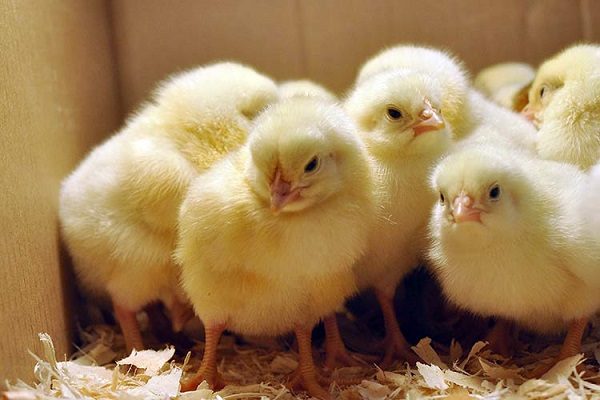
DNA
This method of how to distinguish chickens from chickens from cockerels allows you to determine the sex of chicks most likely. It is based on blot-hybridization of blood DNA with primer.
The young individual can be determined with high accuracy by using a sample analysis or whole blood of washed red blood cells. The disadvantages of this method include the high cost and complexity.
By wings
Determining gender using this method:
- The first way is to inspection of the color of the wings. At the age of 2-3 days, the wings of the chicks are examined — in the males they are slightly lighter than in the females;
- The second way is in counting feathers. It is necessary to delay the wing of the chick and straighten it. Chickens feather first, for this reason, 6-7 primary feathers are large in size, unlike others. But the male feathers are all the same.
To size
Gender chicks determined depending on their size. Usually for this method used high-precision scales. If an individual has a large enough mass for its age, then it is a cockerel. If the mass is small, then it is a female. Usually the weight difference is about 5 grams.
On the subject of growing chickens, read the following articles:
- What to do if chickens do not rush?
- How to use domestic incubator "Layer"?
- How to recognize and treat broiler diseases at home?
How to distinguish the sex of chickens in color?
Determining the sex by the color of the plumage is mainly applied to pedigreeds:
- Crosses. Approximately at the age of 1 day, the sexual characteristics are determined: beige color is characteristic for females, and white for cockerels;
- Autosex breeds. Chickens have a monochromatic color - gray, white, black, and males have stripes;
- Brahma. Females have clear stripes on the back and points on the head. Males also have stripes and dots, but they are slightly blurred;
- Rhode Island and New Hampshire. On the second day after hatching, females can see dark spots and stripes on the head, the males do not have these characteristics;
- Adler silver. The females are yellow and the males are lemon-colored with a black stripe on their heads.
Japanese method
Before you begin to determine the sex with the help of this method is to understand the structure of the genitals of chicks and find out their differences.
Males can be separated from females by detecting a tubercle in the anuswhich is absent in future chickens:
- First of all, the cesspool of the chick is cleared of traces of the litter;
- Next, the individual should be taken in the palm, turn, spread the legs so that the cloaca can be clearly seen;
- The hole must be moved apart, at the same time it is necessary to press the abdomen. As a result of these manipulations, the internal cloacal device will be clearly visible.
External differences of the cloaca of females and males:
- In females, the cesspool looks like a neat knot with no bulges;
- In males, a sexual knob is often found.
To avoid unpleasant consequences, this method should be carried out only by an experienced poultry farmer or farmer.
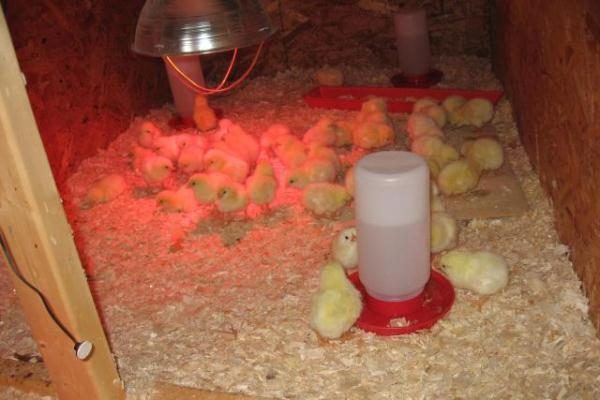
Reflex
How to distinguish chickens by sex by this method? This method of sex determination is performed using two methods:
- Chicks should be taken by the scruff of the neck and some time to look behind the legs. Usually chickens try to twist their pawsand claw claws. The paws at the same time it raises a little. And on the contrary, the roosters do not curl the legs, and do not move them, they hang in an even position;
- It is possible on the contrary to take the chick by the paws and look at the position of the head. Chicks usually lift their heads up, and on the contrary, the roosters hang without moving.
How to distinguish a rooster from a chicken on a voice?
Usually this method is applied to the people of Orpington and Cochinchin. The voice of the males is the roughest, similar to the quack. In females, on the contrary, the voice is more tender, they mostly squeak. This method is not always possible to accurately determine the sexual characteristics of individuals. It is mainly used by experienced poultry farmers.
How to determine the age?
Usually the age of the chickens is determined by the plumage. It is desirable to remember the features of plumage depending on age:
- At the age of between 8 and 12 days the plumage appears in the shoulder area;
- Between 12 and 16 days, feathers appear on the goiter and breast;
- In chicks of three weeks of age, the first molt is observed, with all the fluff falling out of the tail;
- At the end of the fifth week, feathers grow and feathers appear on the back of the body;
- At six weeks of age, the head and lower body are covered with a feather;
- Full plumage is observed at the age of 3 months.
Chicken disease
Chickens, as well as chicks of other species of birds, are prone to various diseases. The most common diseases are:
- Avitominoz;
- Poisoning;
- Digestive disorders;
- Salmonellosis;
- Coccidosis;
- Typhus and many others.
In order to properly cure diseases, it is worth knowing what symptoms are characterized by diseases in chickens.
Chickens diarrhea
Why broilers chickens diarrhea - sometimes quite difficult to understand. Below let's try to understand and understand all the causes of this phenomenon.
White diarrhea in broilers: can it be cured?
Chickens often develop white diarrhea. It is also called pullorosis. This disease usually occurs in an acute form and quickly affects the weak intestines of chickens.The causative agent of this disease is a bacillus called salmonella. The disease usually spreads at a high rate., in a few days, almost all bird stock can get sick.
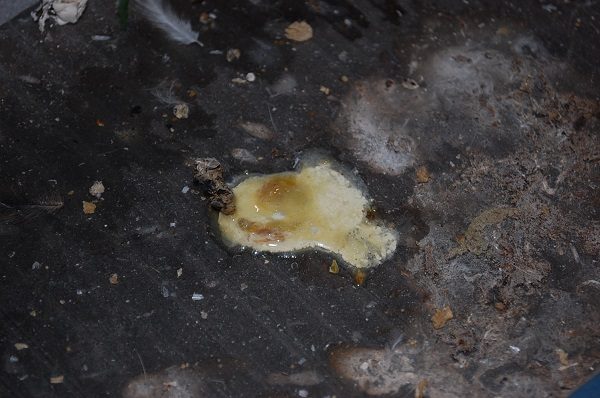
How to cure diarrhea in chickens? For prevention, you need to clean the room from debris, all sanitized. Also be sure to check the temperature in the room and ventilation.
Yellow diarrhea in broilers: why it occurs and how to treat?
This diarrhea can occur during infectious diseases, as well as non-compliance with the conditions of detention. Sometimes yellow litter is observed in Gumboro disease. In these cases, the survey, testing.
Besides yellow diarrhea can result from stress, hypothermia, due to poor-quality feed. In these cases, use of folk remedies for treatment and disinfect the premises.
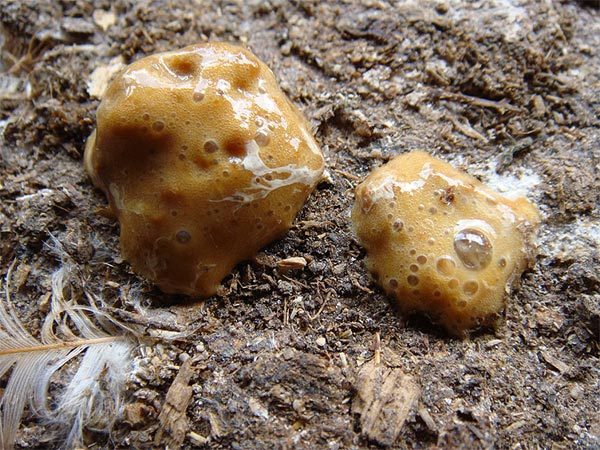
Bloody diarrhea in chickens: a symptom of what diseases?
Bloody diarrhea usually occurs with coccidiosis.This disease is dangerous and often leads to the death of the entire bird population. This disease arises due to poor hygiene, namely the untimely cleaning of the room. This disease affects the intestines. In addition to diarrhea, the following conditions are observed:
- Loss of appetite;
- Lethargy, inactivity;
- Disheveled plumage;
- In the litter there are impurities of blood and mucus.
How to treat if the chickens have diarrhea with blood? For treatment and prophylaxis, it is necessary to clean and disinfect the premises in a timely manner, vaccinate and give appropriate chemicals.
Light brown diarrhea in broiler chickens and its treatment
Brown diarrhea in broilers observed with amerioze. This disease is caused by various parasitic protozoa that accumulate in the intestines of chickens or hens. Infection usually occurs through feed, dirty litter, gadfly.
Symptoms of the disease:
- Individuals sit in one place with their eyes closed;
- Disheveled plumage;
- Wings hung to the floor;
- Lack of appetite;
- Brown diarrhea with mucus.
The disease is determined by the research process. Treatment is best done at the initial stage.For the treatment of drugs used - coccidiostatics.

Chickens diarrhea green
Green diarrhea can occur with the disease of pasteurellosis. In this case, surveys, analyzes are conducted. If the diagnosis is confirmed, then appropriate treatment is prescribed.
In the absence of pasteurellosis, green diarrhea can cause poor quality expired feed. In this case, the treatment is performed using adsorbing agents (activated carbon). Suspicious feed must be disposed of and given only high quality.
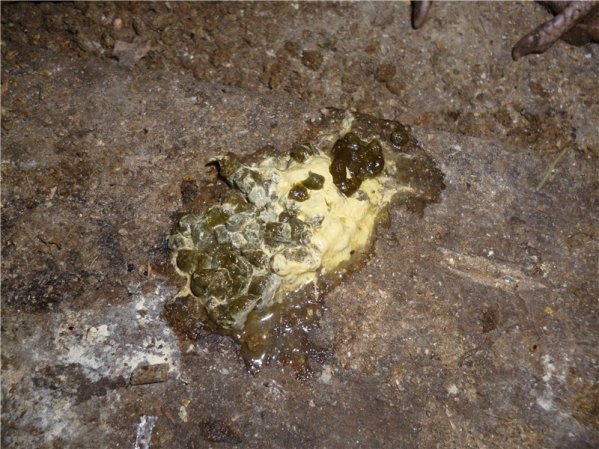
Worms
Often in chickens there is such an unpleasant disease as helminthiasis. This condition is particularly dangerous, and in almost 50% of cases, late treatment leads to death. Signs of worms in chickens - severe exhaustion.
What to do if the worms appeared worms? In order to save all the livestock of birds, it is necessary to sow infected chicks in time,clean the room, clean all bedding and disinfect everything. Infected individuals should be watered with antihelminthic drugs and fed with nutritious food. Medicines against worms for chickens should be given as soon as possible.
Disease prevention
The following recommendations apply to pre-tactical measures for various chick diseases:
- Timely cleaning and disinfection of the room salt solutions, caustic sodium, bleach;
- Compliance with the density of livestock in the house. It is desirable that the number of chicks in the same room is moderate;
- Quality feed with high nutrient content;
- Be sure to equip the ventilation of the room;
- Compliance with the temperature of the room;
- Otpaivanie birds with drugs against infectious diseases;
- Timely vaccination.
Breeding chickens is a rather laborious process that requires a lot of responsibility. In order for the livestock to be healthy, it is necessary to follow all rules of keeping. The main condition for the full growth and development of chicks is care and care!
Now you know,how to grow chickens at home, how to treat chickens, what to do if chickens have worms and how to treat diarrhea in chickens and adults. Follow all recommendations and watch for chicks.
And a video on how to feed chickens:
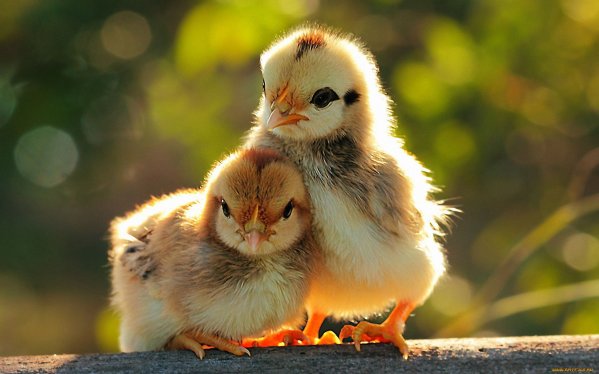
Good day. Tell me, please, exactly how to add vitamin D to feed for the prevention of young rickets? A good incubator, good lamps and temperature, but still afraid of beriberi: there was a negative experience. And when it is necessary to inject vitamin into feed: if, for example, signs of vitamin deficiency have already appeared, for example, they have become noticeably weaker and have had an effect on the plumage - is this treatment already required, or can you try vitaminamin feed? .. Thanks in advance for your reply
Vitamins can try to serve, it will not be worse. But still it is better to contact your local veterinarian.